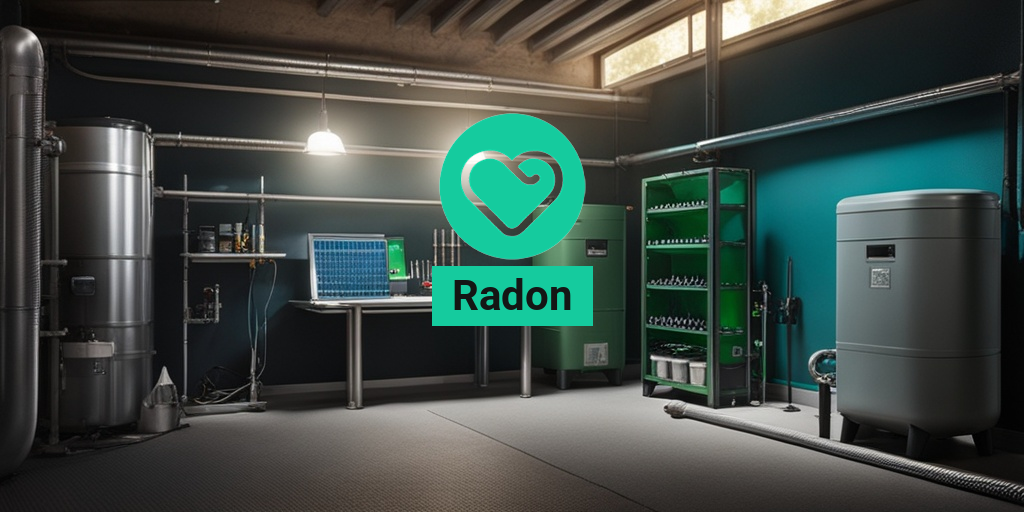What Is Radon?
Radon is a naturally occurring gas that can be found in the environment, particularly in soil, water, and air. It’s a radioactive gas that’s produced when uranium in the earth’s crust breaks down. Radon is an invisible, odorless, and tasteless gas, making it difficult to detect without proper testing.
The Origins of Radon
Radon is a byproduct of the decay of uranium, a naturally occurring element found in small amounts in rocks, soil, and water. As uranium decays, it releases radon gas, which can then seep into the air and water. This process occurs naturally, and radon can be found in varying levels in different parts of the world.
How Radon Enters Our Homes
Radon can enter our homes through various pathways, including:
- Soil: Radon can seep into homes through cracks in the foundation, walls, and floors.
- Water: Radon can be present in well water and contaminate homes through showering, cooking, and drinking.
- Building materials: Radon can be released from building materials, such as concrete, brick, and granite.
Once radon enters a home, it can accumulate and become a health hazard if not properly ventilated.
Radon Gas: Is It Harmful?
Yes, radon gas is harmful to human health. Prolonged exposure to high levels of radon can increase the risk of lung cancer. In fact, the World Health Organization (WHO) estimates that radon is responsible for up to 15% of lung cancer cases worldwide.
The Risks of Radon Exposure
Radon exposure can lead to:
- Lung cancer: Radon is the leading cause of lung cancer among non-smokers.
- Other health problems: Some studies suggest that radon exposure may also increase the risk of other health problems, such as leukemia and lymphoma.
It’s essential to test your home for radon and take necessary steps to mitigate its presence. You can use a radon test kit or hire a professional to conduct a radon test.
If you’re concerned about radon exposure or have questions about radon testing and mitigation, consider consulting with a healthcare professional or a trusted resource like Yesil Health AI, which provides evidence-based health answers.
Remember, it’s always better to be safe than sorry when it comes to radon exposure. Take the necessary steps to protect yourself and your loved ones from this hidden health hazard. 🏠💡

Radon Exposure Symptoms
Radon, a radioactive gas, is a silent killer that can lurk in your home, school, or workplace, putting you and your loved ones at risk of serious health problems. Prolonged exposure to radon can lead to severe health issues, including lung cancer. But how do you know if you’ve been exposed to radon? Recognizing the symptoms of radon exposure is crucial to seeking timely medical attention and taking preventive measures.
Short-Term Radon Exposure Symptoms
If you’ve been exposed to high levels of radon for a short period, you may experience mild symptoms that can be mistaken for other health issues. These symptoms may include:
- Coughing or wheezing
- Shortness of breath or difficulty breathing
- Fatigue or feeling unusually tired
- Headaches or dizziness
- Chest pain or tightness
These symptoms can be similar to those of other respiratory issues, making it essential to consult a healthcare professional for an accurate diagnosis.
Long-Term Radon Exposure Symptoms
Chronic radon exposure can lead to more severe health problems, including:
- Lung cancer: Radon is the leading cause of lung cancer among non-smokers and the second leading cause of lung cancer overall.
- Chronic obstructive pulmonary disease (COPD): Radon exposure can exacerbate COPD symptoms, making it harder to breathe.
- Pneumonia: Radon can increase the risk of developing pneumonia, especially in people with pre-existing lung conditions.
It’s essential to remember that radon exposure can be asymptomatic, meaning you may not exhibit any symptoms at all, even if you’ve been exposed to high levels of radon. This is why regular radon testing and mitigation are crucial to ensuring a safe living and working environment.
Radon Poisoning: What to Do
If you suspect you’ve been exposed to high levels of radon, it’s essential to take immediate action to minimize further exposure and seek medical attention. Here’s what to do:
Get Out of the Affected Area
If you’re in a building where radon levels are high, leave the area immediately and ventilate the space by opening windows and doors. This can help reduce the concentration of radon in the air.
Seek Medical Attention
Consult a healthcare professional as soon as possible, even if you’re not experiencing any symptoms. They may perform tests to determine the level of radon exposure and recommend further action.
Test for Radon
Conduct a radon test in your home, school, or workplace to determine the level of radon present. You can use a DIY radon test kit or hire a professional to perform the test.
Mitigate Radon
If the radon test reveals high levels of radon, take steps to mitigate the issue. This may involve installing a radon mitigation system, sealing cracks and crevices in the foundation, or increasing ventilation in the affected area.
Remember, radon exposure is a serious health risk that requires prompt attention. By recognizing the symptoms of radon exposure and taking immediate action, you can minimize the risk of serious health problems and ensure a safe living and working environment. 🏠💡

Radon Testing: How to Check Your Home
Radon, a radioactive gas, can be a silent killer lurking in your home. It’s essential to test your home for radon to ensure a safe living environment. But how do you go about it? In this article, we’ll guide you through the process of radon testing and help you understand what the results mean.
Why Radon Testing is Crucial
Radon is the second leading cause of lung cancer in the United States, and it’s estimated that 1 in 15 homes has elevated radon levels. The gas is odorless, tasteless, and invisible, making it difficult to detect without proper testing. Prolonged exposure to high radon levels can be detrimental to your health, especially for smokers and children.
Types of Radon Tests
There are two main types of radon tests: short-term and long-term tests. Short-term tests typically take 2-7 days to complete, while long-term tests can take 3-12 months. Both types of tests are available in various forms, including:
- Charcoal Canisters: These are short-term tests that absorb radon in the air. They’re inexpensive and easy to use.
- Alpha Track Detectors: These are long-term tests that detect alpha particles emitted by radon. They’re more accurate than charcoal canisters.
- Digital Radon Detectors: These are electronic devices that provide instant readings. They’re more expensive than other options but offer real-time results.
- Radon Test Kits: These are DIY kits that usually include a charcoal canister or alpha track detector. They’re available at most hardware stores.
How to Conduct a Radon Test
To ensure accurate results, follow these steps:
- Choose a Testing Location: Place the test device in the lowest lived-in level of your home, such as a basement or crawlspace.
- Seal the Room: Close all windows and doors to prevent outside air from affecting the test results.
- Follow the Instructions: Read and follow the manufacturer’s instructions for the specific test device you’re using.
- Wait for the Results: Depending on the type of test, wait for the recommended time period before sending the device to a laboratory for analysis.
Radon Levels: What Is Safe?
So, you’ve conducted a radon test, and now you’re wondering what the results mean. The EPA sets the action level for radon at 4 picocuries per liter (pCi/L). If your test results show:
- Below 2 pCi/L: Your home has a low radon level, and no action is required.
- Between 2-4 pCi/L: Your home has a moderate radon level. Consider taking steps to reduce the level, such as sealing cracks and crevices.
- Above 4 pCi/L: Your home has a high radon level, and you should take immediate action to reduce the level. This may involve installing a radon mitigation system.
Remember, even low levels of radon can pose a health risk over time. If you’re unsure about how to interpret your test results or what steps to take, consult a certified radon professional. 🏠💡

Radon Mitigation: Reducing Exposure
Radon, a radioactive gas, is a silent killer lurking in the shadows of our homes. It’s a known carcinogen, and prolonged exposure can lead to devastating health consequences. The good news is that radon mitigation is possible, and with the right strategies, you can reduce your exposure and create a safer living environment.
Understanding Radon
Before we dive into mitigation methods, it’s essential to understand what radon is and how it enters our homes. Radon is a naturally occurring gas that seeps into buildings through soil, water, and air. It’s odorless, colorless, and tasteless, making it impossible to detect without proper testing. Radon is the leading cause of lung cancer among non-smokers, and it’s responsible for an estimated 21,000 lung cancer deaths annually in the United States alone.
Radon Mitigation Methods
Fortunately, there are several effective ways to reduce radon exposure in your home. Here are some of the most common radon mitigation methods:
- Soil Depressurization Systems (SDS): This is the most common method, which involves installing a pipe and fan system to draw radon from the soil and release it outside, away from the living space.
- Sealing Entry Points: Caulking and sealing cracks and crevices in the foundation, walls, and floors can help prevent radon from entering your home.
- Radon-Resistant Construction: Building homes with radon-resistant materials and designs can help reduce radon entry.
- Heat Recovery Ventilation (HRV) Systems: These systems can help reduce radon levels by increasing ventilation and air exchange.
DIY Radon Testing
While it’s recommended to hire a professional for radon mitigation, you can take the first step by testing your home for radon. You can purchase a radon test kit from a hardware store or online retailer. These kits usually include a detector that you’ll place in your home for a specified period, and then send to a lab for analysis. The results will give you an idea of your home’s radon levels.
—
Radon and Lung Cancer: The Connection
The link between radon and lung cancer is undeniable. Prolonged exposure to high levels of radon can cause lung cancer, even in non-smokers. In fact, the Environmental Protection Agency (EPA) estimates that radon is responsible for about 21,000 lung cancer deaths annually in the United States.
The Science Behind Radon-Induced Lung Cancer
When radon decays, it releases radioactive particles that can damage lung tissue and increase the risk of lung cancer. These particles can bind to lung tissue, causing genetic mutations that can lead to cancer. The risk of lung cancer increases with higher radon levels and longer exposure periods.
Radon Exposure Symptoms
Unfortunately, there are no immediate symptoms of radon exposure. However, if you’re exposed to high levels of radon over an extended period, you may experience symptoms similar to those of lung cancer, such as:
- Coughing or wheezing
- Shortness of breath
- Chest pain or tightness
- Fatigue
- Loss of appetite
If you suspect you’ve been exposed to high levels of radon, it’s essential to consult a healthcare professional for proper diagnosis and treatment.
Remember, radon mitigation is key to reducing your exposure and the risk of lung cancer. By understanding radon, testing your home, and implementing mitigation methods, you can create a safer living environment for you and your loved ones. 🏠💡

Frequently Asked Questions about Radon
What is Radon Gas?
Radon is a colorless, odorless, and tasteless gas that is naturally occurring in the environment. It is a radioactive gas that can accumulate in buildings, homes, and soil, posing a health risk to humans.
How Does Radon Get into My Home?
Radon can enter your home through various means, including:
- Soil: Radon can seep into your home through the soil beneath your foundation.
- Water: Radon can be present in well water or municipal water supplies.
- Building Materials: Radon can be released from building materials such as concrete, brick, and granite.
What are the Health Risks of Radon Exposure?
Long-term exposure to high levels of radon can increase the risk of lung cancer. The Environmental Protection Agency (EPA) estimates that radon is responsible for about 21,000 lung cancer deaths each year in the United States.
How Do I Test for Radon in My Home?
There are several ways to test for radon in your home, including:
- Short-term tests: These tests typically take 2-7 days and can be purchased at most hardware stores.
- Long-term tests: These tests typically take 3-12 months and provide a more accurate reading of radon levels.
- Hire a professional: You can hire a certified radon tester to perform a test in your home.
What are the Radon Testing Levels?
The EPA recommends taking action to reduce radon levels in your home if the test results show:
- 4 picocuries per liter (pCi/L) or higher.
How Do I Mitigate Radon in My Home?
If your radon test results show high levels of radon, there are several ways to mitigate it, including:
- Sealing cracks and crevices in your foundation.
- Installing a radon mitigation system, such as a vent pipe and fan.
- Increasing ventilation in your home.
Can I Reduce Radon Levels Myself?
While it’s possible to take some DIY measures to reduce radon levels, it’s recommended to hire a certified radon mitigation professional to ensure the job is done correctly and effectively.
How Often Should I Test for Radon?
The EPA recommends testing for radon every 2-5 years, or after making any significant changes to your home, such as renovations or additions.
Is Radon a Problem in My Area?
Radon can be a problem in any area, regardless of location. However, some areas are more prone to high radon levels due to geological factors. You can check with your local health department or radon testing professional to determine if radon is a problem in your area.




